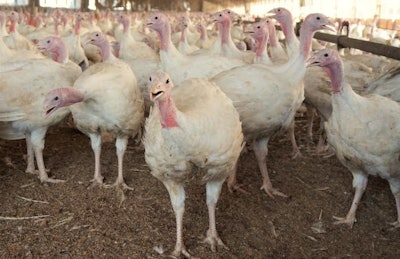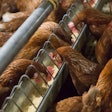
Israel has reported its first outbreak of H5 highly pathogenic avian influenza (HPAI) in poultry since May of 2015. A similar virus has been detected at a farm in Russia’s Ural federal district for the first time this winter.
Stamping-out is already complete at the first poultry farm to be infected with the H5N1 HPAI virus in Israel for more than six years.
According to the initial official report from the country’s veterinary authority, the disease hit a turkey farm at Nahalal in Hazafon (Northern District) earlier this month. The notification to the World Organisation for Animal Health (OIE) outlined an initial 500 cases and 100 deaths among the 42,000 meat turkeys at the site. They were 13 weeks of age.
Slightly elevated mortality was observed in turkeys in one of five pens at the farm. At post-mortem examination, the birds had lesions in their digestive tract.
Three days after the initial notification, a further report mentioned that a further 200 of the birds showed signs of the disease, and 100 more had died. Culling of the remaining 41,800 birds marked the end of the stamping-out process.
Last time this HPAI virus variant was detected in among Israeli poultry was in May of 2015.
First outbreaks in Russia’s Urals of the 2021-2022 season
On October 10, cause of mortality of more than 9,000 birds at a large farm in Tyumen oblast was identified as an HPAI virus of the H5 family. Located at Borovskaya in the Tyumensky district, the premises had more than 1.67 million poultry of unspecified type.
Based on information from the Russian authorities to the OIE, this is the first HPAI outbreak in the Ural federal district of the present season. Previously, the most recent cases were reported in January of 2021.
H5 avian flu virus detected in South Korean wild birds
Last week, the nation’s agriculture ministry reported that wild bird droppings had tested positive for H5 avian flu virus. The samples were taken in the city of Icheon, which is located in the northeastern province of Gyeonggi. Previously, similar samples gathered in the provinces of North Chungcheong and South Chungcheong also produced positive results for this virus family.
In its latest update, the ministry has confirmed that the H5 virus detected is a low-pathogenic type.
During the last winter season, South Korea suffered a series of HPAI outbreaks linked to the H5N8 virus variant. By April, 109 outbreaks in the country had been confirmed. Almost 30 million poultry were culled to halt the spread of infection, with laying hen and duck flocks most affected. So depleted was the nation’s hen population that egg prices rose sharply, and imports of shell eggs were authorized for the first time. This incoming trade lasted at high levels for several months and was scheduled to continue until the end of this year.
To prevent a repeat of this devastating situation, the ministry published official standards for egg production in South Korea earlier this month. Among its key features are information on HPAI prevention, and compensation levels for birds that have to be culled.
In the meantime, the authorities are calling on poultry owners to comply fully with basic biosecurity rules, and to report any suspicious illness or mortality in flocks.
Among the latest regulations to be announced by the ministry are bans on livestock vehicles and workers from habitats visited by migratory birds.
No new HPAI cases in poultry in Laos
According to the latest report from the nation’s veterinary authority to the OIE, there have been no new cases of HPAI in poultry.
At the end of August, one outbreak linked to an H5 virus occurred in a backyard flock of around 400 birds in the east of the country. No further outbreaks have been registered.
Two new human infections with an avian influenza A viruses in China
One new case of avian influenza A(H5N6) in China has been reported by the Centre for Health Protection in Hong Kong. The patient was a 60-year-old woman from Changde in Hunan province. She was a farm who had previous contact with dead poultry. As of October 13, her condition was described a “critical.”
This brings to 49 the number of human cases of this virus worldwide since 2014. All but one of these cases was in mainland China.
At the start of this month, China’s health authority reported to the World Health Organization one new lab-confirmed human infection with an avian influenza A(H9N2) virus. A three-year-old girl from Meizhou in Guangdong province tested positive for this virus. She had a mild illness, and a fever that lasted 2-3 days following previous contact with poultry. No illness was reported in the girl’s family.
So far this year, 18 human infections with this virus have been reported to the WHO in the Western Pacific Region. Since 2015, the number of cases now stands at 59.
Within the past month, concerns have been raised about an apparent recent spike in the number of human cases of influenza of avian origin in China.
View our continuing coverage of the global avian influenza situation.

















